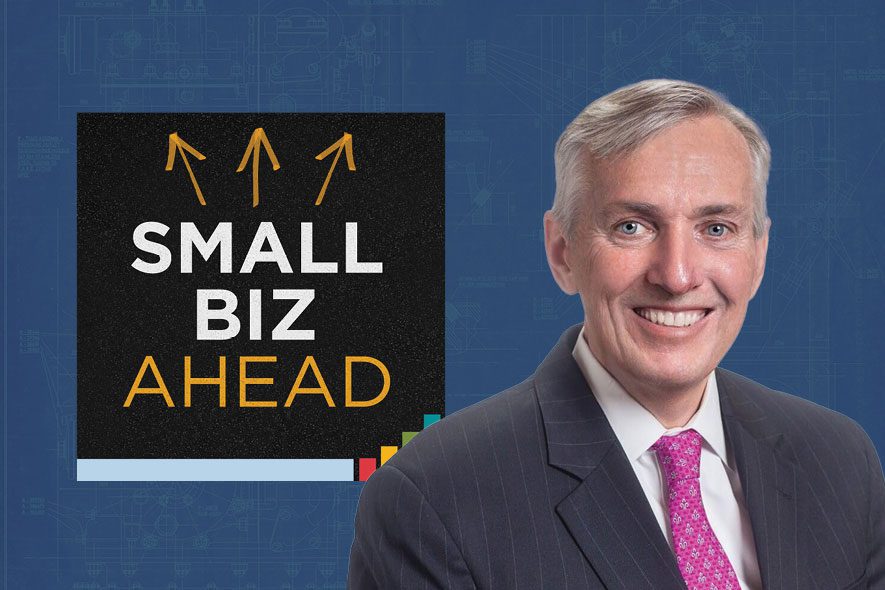Transcript
The views and opinions expressed on this podcast are for informational purposes only, and solely those of the podcast participants, contributors, and guests, and do not constitute an endorsement by or necessarily represent the views of The Hartford or its affiliates.
You’re listening to the Small Biz Ahead podcast, brought to you by The Hartford.
Our Sponsor
This podcast is brought to you by The Hartford. When the unexpected strikes, The Hartford strikes back for over 1 million small business customers with property, liability, and workers compensation insurance. Check out The Hartford’s small business insurance at TheHartford.com.
Gene (00:01):
Hey everybody. This is Gene Marks. And welcome to another episode of the Small Biz Ahead podcast. I am going to give you seven ways that you can protect your business against rising costs. Now look as you know, according to the Bureau of Labor Statistics, the consumer price indexes rose 6.8% from November to November 2021, the largest 12 month increase since the period ending June of 1982. I mean, no one can know how high inflation is gonna go, but most economists agree that inflation is gonna continue to rise in 2022. So what do you do? Right? We know we’re in inflationary time. What do you do to protect your business against rising costs? Well, here are my seven ways. Number one, sweep, extra cash into interest bearing accounts. Look, I mean, for as long as so many of us can remember interest rates have been so low that whether or not we kept our cash in, in regular checking account or an interest bearing account, it really made a little difference.
Gene (00:59):
But look guys, the environment is changing. The federal reserve is likely to increase its federal funds rates. That’s the rate at which commercial banks borrow and lend their excess reserves to each other overnight. As many as three times in 2022 and projected interest rates may rise to anywhere from two to 3% over the next year or two. Now that’s certainly nowhere near the levels we saw in the early 1980s, but it’s still significantly higher than we’ve seen in the past decade. So although this increase the cost of borrowing, which I’ll get to in a minute, it will eventually mean higher payouts on interest bearing assets. So this will likely take some time to occur, but as rates do start to increase, you should make it a practice to start sweeping that extra cash into interest bearing certificates at deposits, money market or savings accounts, and even some bond funds because the earnings will start to make a difference.
Gene (01:49):
Number two, refinance your debt. As I’m speaking to you now, mortgage rates are around 3% and interest rates on a typical bank loan or anywhere from two and a half to 7%, but rates are going up in 2022. We are already talked about that. So now’s the time to lock in on lower rates and convert your short term debt to something longer term, pay down your variable high interest credit card debt, or shift the balance to cards that offer lower rates better yet refinance this debt into a longer term loan with lower fixed interest rates. Even if that means a second loan on an asset like your house or business property, if your business is eligible, consider a section 7A fixed rate loan from a small business administration banker, an SBA banker, where you can borrow up to 5 million for working capital or to refinance your existing debt. Number three, raise prices strategically, and also consider shrinkflation. I mean, you wanna avoid those across the board price increases and instead target your price increases on specific product lines where your margins are most effective and where customers are most likely to be amenable. Do that and do that now. And like many big
Gene (02:59):
Brands, some of my clients are also practicing what’s called shrinkflation or delivering slightly less product or services for the same price. So raise your prices significantly this year and also consider shrinkflation. That’s the third way to combat rising prices. Number four, lock in on long term agreements. If your suppliers are willing lock in on a longer term supply arrangement, if your landlord wants to keep you as a tenant, talk about a longer term lease with agreed on fixed increases. The same goes with higher compensated employees. Look to iron down your relationship with a contract. These changes will help you get a better handle in your cash requirements are giving you more control on your significant fixed costs over the next few years. So you can better budget and manage your cash. Number five, buy inventory, buy property, buy equipment. You ever heard of buying low and selling high, now’s the time.
Gene (03:56):
I mean, my smartest clients aren’t sitting around waiting for prices to rise for those that have access to capital and bank loans. They’re buying the core materials they need for their businesses now, in anticipation of cost, going up in 2022. They’re also investing in property and equipment, which are assets that historically keep pace with rising costs in inflationary times. Do you need financing to do this? Okay, go and get those SBA loans that I just talked about a couple of minutes ago. Number six, invest in technology. Businesses in these inflationary times are doubling down on technology spending in order to get more work done with the same or even less people and keep their overhead under control. They’re investing in robotics for their factories. Self-service kiosks for their stores of restaurants, radio frequency identification and barcoding systems for inventory control and artificial intelligence driven automation.
Gene (04:48):
So that questions can be answered and workflow accomplished without human interaction. Talk to your software and technology partners about what’s affordable for your business. Finally, number seven, revisit your investments like most small business owners, you probably got money saved in various stock and bonds and other asset accounts. Well, now’s the time to talk to your financial advisor depending on your risk tolerance and income. It may make sense to shift some of those investments into commodities like gold and silver. That historically do better in inflationary times. Although these do come with more risk and may not always be your best option. So again, be careful talk to your financial advisor. You may also wanna talk to him or her about increasing your holdings in those larger cap equity funds, because those that may be a good option because the profits generated by well managed companies who stock, you know, are owned by these funds.
Gene (05:40):
They tend to keep up with rising costs. Some of my clients have even looked into tips T I P S treasury inflation protected securities, which are issued and backed by the U.S. government like typical treasury bombs, but come with protection against inflation. Listen, don’t do this on your own. Again, talk to your financial advisor to come up with the right mix of investments based on the risks that you’re willing to take. So seven ways to protect your business against rising costs. One, sweep extra cash into interest bearing accounts. Two, refinance your debt. Three, raise prices strategically and consider shrinkflation. Four, lock in long term agreements. Five, buy inventory, property and equipment. Six, invest in technology. Seven, revisit your investments. Listen, my smartest clients are always thinking ahead. They know that costs, interest rates and prices are going up in 2022. So they’re making these moves now. And so should you, Hey, hope this information is helpful to you guys. If you have any questions or comments or like to reach out to me, please visit us@smallbizahead.com. I’ve got tips, advice, other practical information to help you run your business. And you can get some of the podcast episodes from our Small Biz Ahead podcast as well. Hope you found this interesting. Thanks very much for your time. My name is Gene Marks. We will see you again next week on the Small Biz Ahead podcast. Take care.
Download Our Free eBooks
- Ultimate Guide to Business Credit Cards: The Small Business Owner’s Handbook
- How to Keep Customers Coming Back for More—Customer Retention Strategies
- How to Safeguard Your Small Business From Data Breaches
- 21 Days to Be a More Productive Small Business Owner
- Opportunity Knocks: How to Find—and Pursue—a Business Idea That’s Right for You
- 99 New Small Business Ideas





